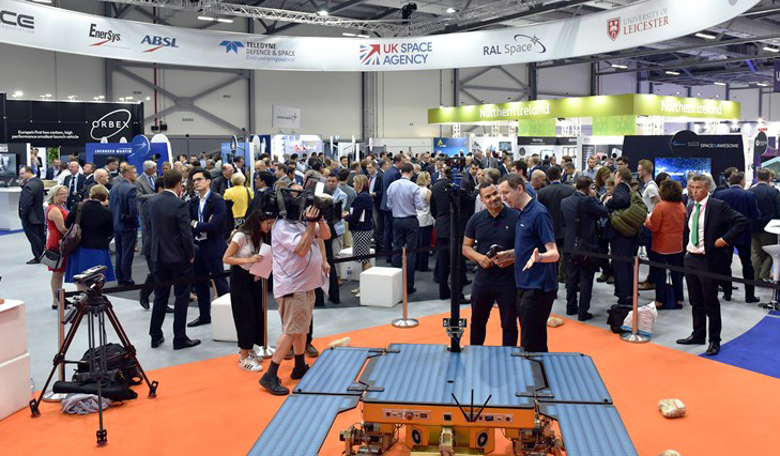The space pavilion at the recent Farnborough airshow in the UK was the place to be, as both government Minister Greg Clarke and the Prime Minister, Theresa May commented positively about the support needed for the UK aerospace industry to continue flourishing as it has been doing for a number of years now. The current boom in aircraft orders - £134 billion worth of aircraft and engines at this year’s event – is hoped to be reflected in increased satellite manufacturing orders, with Euroconsult forecasting a demand for 300 new satellites over 50 kilograms per year by 2026.
The UK plans to achieve a 10 percent share of the market by 2030, worth some £40 billion, but in the ensuing Brexit negotiations, FIA visitors were conscious of how prevailing issues may affect UK satellite manufacturing, in particular what might become of the £9 billion Galileo navigation system that is up for grabs. Currently the EU is blocking UK firms like ADS and SSTL from competing for this lucrative series of contracts on encryption sensitivity grounds, which has prompted the UK government to discuss possible plans of going ahead with its own national GPS system instead.
At the FIA it was also noted that new government initiatives such as UK spaceports and licensing for launch activities should accelerate the nations international standing in the world for space industry growth.
Two key announcements were also made in regards to two new Spaceport investments at the opposite ends of the country. Firstly, the UK Space Agency announced that it was supporting the site at the A’ Mhoine peninsula in Sutherland, as being the first vertical launch orbital access Spaceport in Britain for northward direction polar orbit and high inclination Sun-synchronous satellite payloads.
The government is giving the Highlands and Islands Enterprise economic development agency £2.5 million to start work, subject to the normal environmental impact tests required for major project planning permissions.
The second funding announcement related to a £26.5 m award to Lockheed Martin and £4.2m to Orbex to commence satellite launch work at the Sunderland site. Lockheed will use a small launcher, such as Rocket Lab’s Electron or another small rocket and the Orbex start-up company will develop the small bio propane fuelled “Prime” launcher, built by Moog in the UK, for 150 kg sized small satellites .
Meanwhile, elsewhere in the country, the UK government is also providing £2.5 million to contenders for horizontal launched satellite Spaceports. Following the May 2016 announcement that the UK government was allowing the market to select more than one horizontal launch site for orbital access, Prestwick near Glasgow, Llanbedr in Wales and Newquay in Cornwall have emerged as prime contenders.
For 2021 timescale launches, the government is committed to bringing in new orbital and sub-orbital licensing regulations to clarify matters and is currently working closely with the CAA and DfT to achieve this target.
New funds for Reaction Engines
UK based Reaction Engines (RE) have been working steadily towards the development and testing of SABRE, the “Synergistic Air-Breathing Rocket Engine”. This engine will achieve both air-breathing and rocket modes, allowing for hypersonic air travel at Mach 5, or orbital access velocities of Mach 25 for spaceplanes like “Skylon”.
RE are supported by their US subsidiary at Castle Rock, Colorado, “Reaction Engines Inc.” and are part-funded by the UKSA and ESA, with BAE Systems, Boeing and Rolls Royce as minority investors.
The company also revealed at the FIA that it had received £100 million to press ahead with the development of its SABRE engine, which will take place at their new test facility at Westcott in Oxfordshire.
Exomars naming competition
Bolstering interest in ESA's Exomars mission due for launch in 2020, astronaut Tim Peake was on hand to kick-start the rover naming competition.
The rover is planned to land on Mars in the Spring of 2021, following its 2020 launch on a Russian Proton rocket. Using a Roscosmos built lander, the Exomars Rover will spend a year on the Martian surface drilling two metres into the soil, to seek out possible past or current microbial life in the subsurface soil.
The UK, which is building the rover at the Airbus factory in Stevenage, won the naming rights at the ESA Ministerial Council in 2014 as it is the key financial contributor.
The closing date of the competition is 10 October 2018 and single words, an acronym or a combination of words will be considered. However full details can be found on the UKSA website. Anyone resident in the UK or another ESA associated country can apply.











